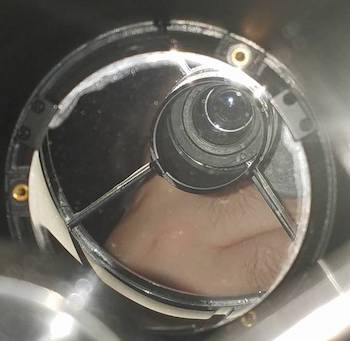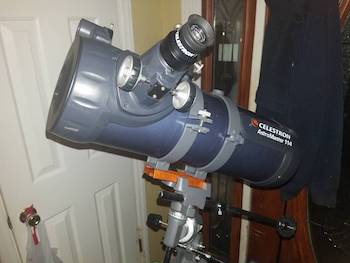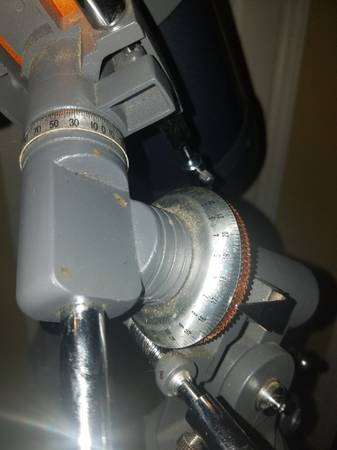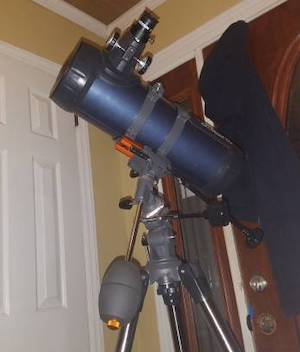The Birds and the Jones: The Optical Tube Assembly
The primary mirror is 114 mm in diameter and has a spherical curve with a focal length of f/8.77. It can provide a minimum magnification of 16x, and a maximum magnification of 220x, though both extremes would require aftermarket eyepieces.

The 114EQ uses a Bird-Jones optical arrangement. It pretends to be a Newtonian telescope, except that the focal length is much longer than the tube itself. How does this work? A corrector lens is placed in the optical path both to correct for the spherical aberration of the primary mirror and to compress the light path to fit into a shorter tube. In theory, such an arrangement could be a good, cheap alternative to a parabolic Newtonian, especially when it was invented–in the days before correctly figured parabolic mirrors were common in mass-market telescopes. In practice, though, pretty much every Bird-Jones is implemented incorrectly, with the corrector lens in the focuser.
Why is this a problem? The focuser moves to accommodate different eyepieces and different eyes. Thus, the corrector lens could never have a chance of actually correcting for spherical aberration–it only corrects at one specific distance from the primary mirror. Although the correctors in these Bird-Jones don’t seem to be actual correctors anyway, merely Barlow lenses which increase the effective focal length of the telescope.
The focuser itself is a simple rack-and-pinion focuser for 1.25” eyepieces. It’s actually quite ergonomic to use, with very nice knobs and smooth motion.
The mirror is not center-spotted for collimation, and unfortunately, Bird-Jones scopes are very difficult to collimate. The Celestron Astromaster 114EQ does have collimation thumbscrews on the back, but you’ll need special optical tools to reasonably collimate the scope–and you may need to take the corrector lens out.

The optical tube is decorated with large plastic elements on the front and back. These interfere with the tube rings and prevent the telescope from being properly balanced on its mount. The old versions of the telescope, including the one I had, had a red illuminated “Starfinder” which was simply two red-illuminated reticles on glass plates that you would align your head through the middle of to see out the front. It was permanently attached to the tube and had no provisions for realignment. The current versions of the telescope don’t have this permanently attached star finder, but instead provide the fittings for a removable true Red Dot Finder.
The telescope’s optics are not as good as what a similar-sized telescope with a true parabolic mirror can show, but the optics are honestly forgivable. For most of my observing, I never noticed any truly ugly blurry views, and while a real parabolic mirror would certainly perform better, the optics are not the worst part of this telescope. If this telescope had been fashioned as a tabletop dobsonian, and if the corrector lens had been placed in a static position, it might have been decent. Unfortunately, it shipped with a CG-2 equatorial mount, which is a reason why this Celestron AstroMaster 114EQ review is not that positive.
The CG-2 Equatorial Mount
This is the single worst aspect of the AstroMaster 114EQ. Nothing about this mount is acceptable for this application. The CG-2 (rearranged slightly as the CG-3, and mostly identical to the EQ-1 mount sold by other manufacturers) is actually a decent mount on its own, but when paired with this telescope, it is an unholy abomination. The telescope is simply too heavy for this mount. As a result, it is full of backlash, sloppy motion, and slipping. It needs to be balanced just right for the right ascension knob to actually result in slewing along the right ascension axis. On many occasions, I would have the telescope pointed just where I wanted it, then I would let go, and the RA gear would drop slightly, the whole telescope would fall down, and what I was looking for would be lost, sometimes requiring minutes to find it again.
Also, an equatorial mount is a terrible idea for a beginner telescope. Most beginners have a relatively poor understanding of the motions of the night sky (something that can be improved by constantly observing the sky!). And you must have an understanding of such motions to correctly use the mount. Using it correctly also requires several minutes of setup and alignment.
For the first few years of owning this telescope, I didn’t really understand how the equatorial mount was meant to work. Oftentimes, an equatorial mount will put a Newtonian’s eyepiece in an uncomfortable position. The correct way to deal with this is to rotate the optical tube within its tube rings. I would often simply move the whole tripod base to a different position to fix the problem. Even once I did eventually learn how the equatorial mount was supposed to work, I found it less finicky most of the time to just tilt the altitude axis on the mount so that it points straight up, and use it as a strange sort of altitude-azimuth mount.
The mount tends to run into itself occasionally. This is usually solved by moving the conflicting slow-motion knob to the other side of the mount.

The telescope has two useless setting circles for Right Ascension and Declination. In theory, these are used to align with a given object and use them to find a different object by moving the telescope until the RA and Dec displayed on the circles match that of the target object. In practice, they’re nowhere near precise enough to get you to the object you’re looking for–a star-hop is more fun. To make matters worse, they don’t always turn with the telescope; sometimes they slip.
The telescope is attached to the mount by a standard dovetail with tube-rings, so it can be placed on any compatible mount, such as the AstroMaster Alt-az mount or a larger Equatorial Mount.
The mount comes with two quite ergonomic Right Ascension and Declination slow-motion knobs, which are much nicer to hold in the hand and turn compared to those supplied with the PowerSeeker and other manufacturers’ EQ-1 mounts. I lost my slow motions after having removed them since they kept running into each other. I replaced mine with PowerSeeker knobs, but they’re much less comfortable.
The tripod is sturdy enough actually, and it comes with an eyepiece tray, which I used occasionally. It isn’t a large enough tray to support the accessory kit box, though!
What does the telescope come with?
The accessories of the AstroMaster telescopes have changed somewhat since I received mine in 2016. When I got mine, it came with a perfectly acceptable set of Kellner (three-element) eyepieces. A 20mm eyepiece provides 50x magnification, and a 10mm eyepiece provides 100x magnification when used with this telescope.
Well, times have changed, and now Celestron wants to market this telescope in science gift shops under the guise of terrestrial viewing. Terrestrial viewing really is not suited for a Newtonian! So they include a 20mm erect image eyepiece, which is of poor optical quality and is not really suitable for clear astronomical viewing. I recommend replacing the 20mm eyepiece with a nice 25mm Plossl, or at least a 20-25mm Kellner.
The telescope now comes with a “Red Dot Finder,” which projects a red dot onto the sky. In my experience, this type of red dot finder is actually a joy to use. Once aligned, the red dot will appear, seen through the finder’s window, as if it were projected onto the night sky with no parallax (i.e., as you move your head slightly, the red dot finder does not move against the stars). Not everyone likes them, but they’re certainly better than a cheap magnifying finderscope.
Celestron sells three relevant accessory kits to supplement its AstroMaster and PowerSeeker telescopes:
- The PowerSeeker accessory kit, which I actually got (and still use), contains a 15mm Kellner, a 9mm Kellner, and three filters: an #80A light blue filter, a #25 dark red filter, and a cheap dark Moon filter, which I never use and you don’t need. The 15mm eyepiece is a nice middle-ground between the 20mm and 10mm, but the 9mm is redundant when paired with the AstroMaster’s 10mm. The 80A filter is actually quite useful for bringing out details on Jupiter, Saturn, and Mars.
- The AstroMaster accessory kit, which includes a 2x Barlow (not a very good one, but much better than the 50 cent one that comes with many of the PowerSeekers and AstroMasters), a 9mm eyepiece (again redundant with the 10mm), and a 6mm eyepiece, which is actually a good idea for planetary viewing, although it will be uncomfortable to use if you wear glasses due to its small eye lens. It also includes the same filters as the PowerSeeker’s kit. The 6mm eyepiece, when doubled with the Barlow produces a magnification of 333x, which is way too much for this telescope. But the 6mm alone produces a reasonable 167x, which is good for planetary detail that might otherwise be elusive.
- The CG-2/CG-3 Motor Drive kit – This allows you to have the telescope automatically track in the Right Ascension axis at the cost of preventing you from using the RA slow motion. This effectively allows you to cancel out the motions of the sky. This might work on a new CG-2 mount, but by the time I bought one for my 114EQ, the mount seems to have been worn out by being used with such a heavy telescope. This can allow the telescope to be used for very basic astrophotography with exposures of about 30-60 seconds as opposed to less than a second for untracked shots. It did not work at all for me, but I can’t rule out the possibility of it working on a new CG-2 mount or with a lighter telescope.
If you’re going to build up your own accessory kit, I recommend getting a 25mm and/or 32mm Plossl for wide-field views (good for finding objects and for taking in large clusters and nebulae), and a 6mm Goldline for planetary and lunar views.
Should I buy a used Astromaster 114EQ?
Since these telescopes are often hobby killers, you will occasionally see them crop up on eBay or Craigslist for much cheaper than their original price. If you can get one for under 80 dollars, I’d say it might be worth the cost. If you get one as your first telescope, you’re risking it being a hobby-killer, as the mount can be very frustrating. However, it may be possible to fit the telescope tube on a tabletop dobsonian base (they sometimes crop up without a telescope tube on eBay), or you could build your own dob base out of wood and Teflon. In that configuration, it might be worth it.
What to see?
I was able to make out the cloud bands on the tiny disk of Jupiter on some nights, but it was much more difficult than it ever should have been. I don’t think I ever saw the Great Red Spot with this telescope–but I wasn’t keeping logs then.
This telescope was the first one that showed me Saturn’s rings. I remember excitedly setting it up on the balcony of the hotel in the mountains where I first set it up and shouting a bit too loudly that I’d seen the rings! It’s not all bad memories with this telescope… just the vast majority of them.

The Moon is always nice to look at through a telescope, and there’s no exception here. You can see fairly high detail in individual craters, but it’ll always look softer and fuzzier than it should–not the crisp image you’d expect from a good telescope.
If you can deal with the annoying mount, there are dozens of deep-sky objects to look at. The Orion Nebula looks good in pretty much any telescope. Lots of double stars can be split as well.
Nothing in this telescope is as clear and crisp as it should be, but the optical flaws are not the worst part of this telescope; the mount and the price tag are.


The Astromaster and PowerSeeker Bird-Jones optical design scopes shouldn’t even have Newtonian in their prospective titles. Avoid any telescope that is advertised as a Newtonian where you have to hunt through their specifications to see if the primary mirror is parabolic. If it has a cheap and lousy optical design that incorporates a cheap spherical mirror the specs won’t tell you that it has a cheap spherical mirror. Celestron Cometron Newtonian has a parabolic mirror. My Vixen R130Sf Newtonian has a very nice parabolic mirror. If there is no mention of a newtonian having a parabolic mirror, keep searching.
I had a Celestron PowerSeeker 127mm. I had to remove the image corrector to collimate it properly and it still wouldn’t give me a sharp image out the edges when viewing just the moon. It left me forever adjusting the focus which just wouldn’t get the complete eyepiece view focused in.
The above exhaustive review is on point. Avoid these types of scopes with a spherical mirror and an image corrector in the end of the focuser tube.